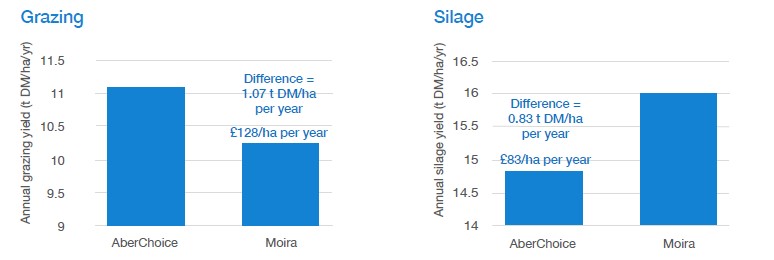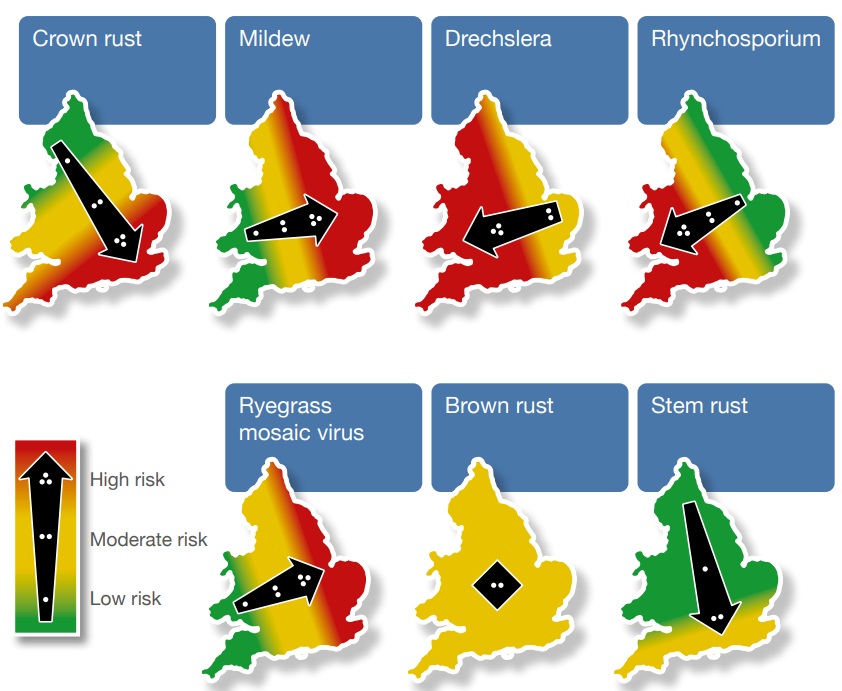- Home
- Knowledge library
- Three key steps to selecting varieties
Three key steps to selecting varieties
Find out why choosing the most appropriate traits for your farm is an important part of grassland reseed. Find out why the Recommended Grass and Clover Lists are so important.
Selecting varieties
Ryegrass varieties have improved through breeding programmes in the UK, which have influenced:
- Yield
- Quality
- Digestibility (estimated to have increased by 10 g/kg DM)
These improvements mean there is a significant financial return by using the latest grass genetics. Choosing the varieties best suited to individual fields is key to a reseed, to maximise the return on investment. There are more than 900 perennial ryegrass varieties available in Europe, so it is important to distinguish which ones will perform the best on the farm.
Improvements in yield and quality due to breeding
|
Variety | Gain per year (%) | Gain in total DM yield (t/ha) | Financial gain over five years (£/ha) | |
|---|---|---|---|---|
| Perennial ryegrass | Silage | 0.35 | 1.6 | 224* |
| Grazing | 0.51 | 2.8 | 308^ | |
| Italian ryegrass | Silage | 0.37 | 2.5 | 350* |
| Hybrid ryegrass | Silage | 0.26 | 1.0 | 140* |
*silage valued at £140/t
^grazed grass valued at £110/t
There are three key steps to selecting varieties.
Step 1: Is it on the Lists?
When selecting grass mixtures, check that the varieties listed are present on the latest version of the Recommended Grass and Clover Lists (RGCL). In the UK, the RGCL are drawn up after rigorous testing for attributes such as:
- Yield
- Persistency
- Quality
- Disease resistance
Varieties are tested at sites across England, Scotland, Wales and Northern Ireland, across a number of years, to provide information on their performance over a range of climates and soil types. From this testing, the best-performing varieties are selected. As few as one in 20 varieties tested actually make it to full recommendation, classified as (G).
Step 2: What will the sward be used for?
Individual varieties can perform better under silage than grazing management and vice versa. It is important to consider whether the reseed will be mostly cut or mostly grazed, as selecting the correct variety for use can have a significant impact on financial returns. For example, diploids Moira (heading date – 24 May) and AberChoice (heading date – 10 June) perform very differently under silage and grazing management, resulting in differences of approximately £100/ha in yield.
Comparison of two varieties for grazing and silage performance

The RGCL testing programme provides specific data for all varieties for both silage and grazing management. There is more information on the performance of individual varieties in the RGCL guide.
Selecting for grazing-specific swards:
- Choose top-performing varieties under grazing management in the RGCL
- Select varieties with high digestibility
- In wetter areas, choose varieties with higher ground cover
- Match seasonal growth of variety to grazing demand (see Step 3)
- Later-heading grasses tend to perform better in grazing than silage swards
- Aim for a maximum heading date range of 15 days
- Aim for a maximum tetraploid content of 20% on wet soils
Selecting for silage-specific swards:
- Choose top-performing varieties under silage management in the RGCL
- Aim for a maximum heading date range of seven days
- Earlier-heading grasses tend to perform better in silage swards
- Choose varieties with high digestibility
Step 3: Which traits are most important for the farm?
Once the purpose of the ley has been chosen and a subset of varieties identified from the RGCL, individual traits most important to the farm should then be considered. Varieties are tested for attributes such as seasonal growth, ground cover and disease resistance.
Seasonal growth
The seasonal growth of individual varieties is strongly influenced by heading date. Early-heading varieties produce higher yields in spring, with late-heading varieties exhibiting the highest yields in summer and autumn. However, within heading date classes (early, intermediate, late), there are large differences between varieties. Farmers seeking to maximise the use of grass at the shoulders of the season should consider varieties with high spring and autumn grazing yields.
The variation in timing of yields based on heading dates

Ground cover
Varieties are assessed for ground cover in autumn using a scale of 1 to 9, where 9 equals good and 1 equals poor. This gives an idea of the density of the sward. Ground cover is also measured in the second and third harvest year, to provide an indication of variety persistency. Typically, diploids will have better ground-cover rankings and are more suitable for wet soils or soils prone to poaching.
Winter hardiness
Assessed by scoring grass plots for ground cover after their first winter. Varieties with a greater winter-hardiness ranking are more tolerant to hard frosts and cold soil temperatures. Winter hardiness is ranked on a scale of 1 to 9, where 9 is good and 1 is poor.
Disease resistance
Scored on grass plots during the autumn. It is reported on a scale of 1 to 9, where 9 is good and 1 is poor. There are a number of plant diseases that can affect yield, quality and sward composition in ryegrass leys. Responses to fungicide treatments have been varied, but it is estimated that disease can cause crop losses of over 1 t DM/ha over a three-year period. In addition, diseases such as mildew and rhynchosporium in Italian ryegrass have been shown to reduce D-value by 1–2 units. Depending on the farm’s location, varieties can be selected with good resistance to these diseases.
The risks of disease based on location (from RGCL guide)

Nutrient-efficient grass varieties
With rising fertiliser costs and a greater focus on reducing losses to the environment, improving the efficiency with which nutrients such as nitrogen and phosphorus are used is becoming increasingly important in livestock systems. Recently, researchers at Aberystwyth University have been working on developing grass and clover varieties that use nutrients more effectively. These include:
- Clover plants with a lower requirement for phosphorus
- Grass plants with a higher water-soluble carbohydrate content to improve nitrogen use efficiency in the rumen
- Red clover with higher polyphenol oxidase – an enzyme that can protect protein from degradation and so will reduce nitrogen losses to the environment
Drought-tolerant grass and clover varieties
Grass and clover roots have an important role to play in balancing soil water stores. Root channels are often used for water flow during the winter months, reducing the chance of flooding on the soil surface. Meanwhile, during drought conditions, good rooting capability ensures growth rates remain high. Scientists at Aberystwyth University are working to develop new grasses and clovers with better rooting structures to enable them to capture increased volumes of rainfall in winter months and survive drought conditions in summer months.
The grass research is focusing on festulolium, which is a hybrid between fescue (meadow or tall) and ryegrass (perennial or Italian).
Useful links
Read the Recommended Grass and Clover Lists
Order printed resources online using the AHDB catalogue
Back to: Choosing the correct grass species for a grassland reseed
Topics:
Sectors:
Tags:

